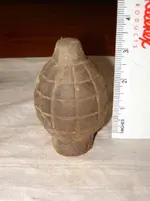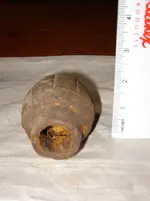Centralvic
Jr. Member
- Joined
- Sep 20, 2008
- Messages
- 31
- Reaction score
- 0
- Golden Thread
- 0
- Location
- Hanging Rock Victoria
- Detector(s) used
- Whites DFX
Also from Alsace in France, I have been told the grenade is French and that instead of a metal handle
which would be released and activate the fuse, these had a match of some description in the open end
and the fuse would be activated by hitting the top of the grenade against something solid.
When found the grenade was still full of degraded explosive, I found several during the day which like this
one had not exploded.
which would be released and activate the fuse, these had a match of some description in the open end
and the fuse would be activated by hitting the top of the grenade against something solid.
When found the grenade was still full of degraded explosive, I found several during the day which like this
one had not exploded.








